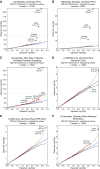Exome-Based Rare-Variant Analyses in CKD
- PMID: 31085678
- PMCID: PMC6551770
- DOI: 10.1681/ASN.2018090909
Exome-Based Rare-Variant Analyses in CKD
Abstract
Background: Studies have identified many common genetic associations that influence renal function and all-cause CKD, but these explain only a small fraction of variance in these traits. The contribution of rare variants has not been systematically examined.
Methods: We performed exome sequencing of 3150 individuals, who collectively encompassed diverse CKD subtypes, and 9563 controls. To detect causal genes and evaluate the contribution of rare variants we used collapsing analysis, in which we compared the proportion of cases and controls carrying rare variants per gene.
Results: The analyses captured five established monogenic causes of CKD: variants in PKD1, PKD2, and COL4A5 achieved study-wide significance, and we observed suggestive case enrichment for COL4A4 and COL4A3. Beyond known disease-associated genes, collapsing analyses incorporating regional variant intolerance identified suggestive dominant signals in CPT2 and several other candidate genes. Biallelic mutations in CPT2 cause carnitine palmitoyltransferase II deficiency, sometimes associated with rhabdomyolysis and acute renal injury. Genetic modifier analysis among cases with APOL1 risk genotypes identified a suggestive signal in AHDC1, implicated in Xia-Gibbs syndrome, which involves intellectual disability and other features. On the basis of the observed distribution of rare variants, we estimate that a two- to three-fold larger cohort would provide 80% power to implicate new genes for all-cause CKD.
Conclusions: This study demonstrates that rare-variant collapsing analyses can validate known genes and identify candidate genes and modifiers for kidney disease. In so doing, these findings provide a motivation for larger-scale investigation of rare-variant risk contributions across major clinical CKD categories.
Keywords: genetic renal disease; human genetics; molecular genetics.
Copyright © 2019 by the American Society of Nephrology.
Figures



References
-
- Webster AC, Nagler EV, Morton RL, Masson P: Chronic kidney disease. Lancet 389: 1238–1252, 2017 - PubMed
-
- United States Renal Data System : USRDS Annual Data Report: Epidemiology of Kidney Disease in the United States, Bethesda, MD, National Institutes of Health, National Institute of Diabetes and Digestive and Kidney Diseases, 2017
-
- Freedman BI, Soucie JM, McClellan WM: Family history of end-stage renal disease among incident dialysis patients. J Am Soc Nephrol 8: 1942–1945, 1997 - PubMed
Publication types
MeSH terms
Substances
Grants and funding
LinkOut - more resources
Full Text Sources
Other Literature Sources
Medical
Miscellaneous

